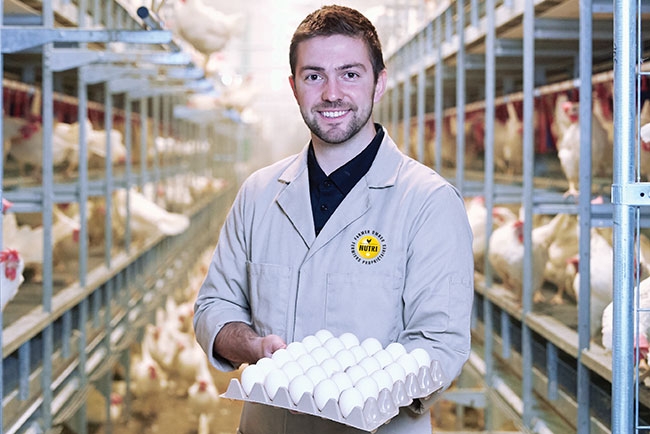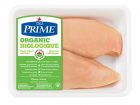
Industry Overview: Organic upsurge
By Treena Hein
Features Business & Policy Emerging TrendsThe details on growth of Canadian organic egg and chicken production.
 Some producers, like David Lefebvre, worry the current review of the Canadian Organic Standards will lead to higher costs and decreased capacity. PHOTO CREDIT: Ferme St-Ours
Some producers, like David Lefebvre, worry the current review of the Canadian Organic Standards will lead to higher costs and decreased capacity. PHOTO CREDIT: Ferme St-OursWhether it’s attributes such as flavour or texture, perceptions of health benefits, more availability or other reasons, demand among consumers for Canadian organic poultry products is growing.
Organic chicken producers in Canada both sell directly to their customers, such as Whispering Meadows in Desboro, Ont., and also supply larger food companies. Windberry Farms in Abbotsford, B.C., for example, started organic chicken production in 2011 and markets it through Fraser Valley Specialty Poultry.
What’s more, several organic chicken producers in Ontario are now supplying the new Maple Leaf organic program. In May, the company launched Maple Leaf Prime Organic Chicken in Eastern Canada through two major grocery store chains, Metro and Sobeys. It’s a full line of popular consumer cuts that includes boneless skinless breasts, boneless skinless thighs and whole birds.
As for some of the other large firms, Maple Lodge offers one organic product so far, shaved deli oven-roasted chicken breast. And Peterborough, Ont.-based Yorkshire Valley Farms, Canada’s largest organic poultry producer at present, currently offers organic chicken, eggs and turkey products, including value-added fully-cooked meatballs and chicken pot pie. Both Loblaw (President’s Choice) and Wal-Mart currently offer organic eggs and more.
Maple Leaf says it’s pleased with its Prime Organic Chicken product sales since the launch this spring. In terms of feed sourcing, the Maple Leaf media team explains that the feed ingredients for its independent organic producers are purchased both within Canada and beyond.
“Meeting the requirement to be organic requires specialized non-GMO feed, which has some supply constraints. To this point, we’ve been able to secure adequate supply for our current program.”
Opening up new markets
To help develop both domestic and foreign markets for all organic products, the Canadian Organic Trade Association (COTA) has been awarded $992,000 from the federal Canadian Agricultural Partnership (CAP) Agri-Marketing Plan over the next three years.
Opportunities to promote the ‘Canada Organic’ brand will be explored and some market access issues will be addressed. “Existing market issues are related to adventitious glyphosate residue on organic products, creating market barriers for export sales mostly, as well as GMO contamination issues,” notes COTA Executor Director Tia Loftsgard. “Issues of organic integrity are also addressed through our programming in which we look at any issues that might compromise or pose a risk to the industry.”
COTA is also reviewing import requirements and practises required by the federal government and existing related data gaps that prevent the industry from properly evaluating business opportunities or challenges.
Update on Canada’s organic poultry leader
Organic poultry leader Yorkshire Valley Farms has had an active couple of years. Two years ago, the company launched its organic pasture-raised egg program for the 2017 season.
In addition to following organic practices, farmers in the pasture-raised program provide an enhanced pasture area for hens to forage outdoors. As with all Yorkshire Valley Farms laying hens, the pasture birds enjoy organic non-GMO feed and a cage-free environment in which to lay their eggs.
Since ‘pasture-raised’ is not a defined labelling term in Canada, Yorkshire Valley Farms worked to create a set of standards to which all participating pasture farmers must adhere.
These pasture-raised criteria incorporate the organic standards, while also requiring that hens spend a minimum of six hours outdoors per day, weather permitting, in an organically managed pasture that offers at least 20 ft2 (1.85 m2) per hen.
The realities of the Ontario climate mean that this enhanced pasture access can only be ensured for a limited period each year. The pasture program generally runs from late May to October and the eggs are offered as a special seasonal offering.
When consumers buy a Yorkshire Valley Farms product labelled ‘pasture’, they are getting a product that comes from animals that have truly spent time outdoors, foraging on pasture.
Then last year in Ontario, Yorkshire Valley Farms finished a market expansion project supported by a $45,000 grant from the Greenbelt Fund. The funding helped the organic poultry producer expand its existing Small Organic Egg Program to 13 pasture-organic producers, expand market reach for these eggs and develop a new logo for cartons and point-of-sale materials, explains Greenbelt program manager Sagal Dualeh.
A video with one of the farmers was also created. Dualeh says the grant amount was below average and that Yorkshire Valley was chosen, among other reasons, because it had an existing market network where expansion was deemed achievable.
Reflections from an experienced producer
The Lefebvre family, who own and operate Ferme St-Ours in Saint-Ours, Que., decided to start organic egg production at the end of the 1990s when demand for organic eggs started to emerge. In 1999, they began organic egg production with 2,500 organic layers, and by the end of 2020, they will reach 76,000 organic layers (they also raise all their own pullets).
Also by the end of next year, all birds on the farm (about 200,000 layers and pullets in total) will be housed in free-run systems (they also produce non-organic eggs on the farm).
David Lefebvre says the most significant current challenge in organic egg production is layer health. “As they have access to outside, we need to be rigorous in the way to manage the layers’ outings, especially in the periods of bird migrations,” he says. “Another challenge is the feed.”
Twenty years ago, when the Lefebvres started organic production, certification required that part of the feed be produced on-farm, and so the family converted their crop production to organic.
“At the beginning, we bought the organic feed, but the quality was irregular,” Lefebvre remembers. “As we had begun our own organic grains production, we decided to build a feed mill in 2003, so that we could…have better control of the quality. Today, we produce a part of the organic grains needed to produce the organic feed for organic layers and organic pullets, and we buy organic grains from different local certified producers.”
The Lefebvres are also concerned about the regular five-year review of the Canadian Organic Standards occurring right now. Contributed feedback from stakeholders is open for public response this summer, and final updates to the standards will be in place by late 2020. Lefebvre fears that these updates might result in increased costs and production capacity decreases, as well as increased risk to layer health.
Regarding proposed updates, in early July 2019, the Organic Council of Ontario (OCO) reported that the associated ‘Working Group on Livestock’ “has had many heated debates on poultry farming conditions. The Revised Standard proposes, among other changes, to provide shade on outdoor runs, clarifies requirements for access to the outside and perches, and introduces the concept of ‘winter gardens.’” Watch OCO’s webinar on poultry outdoor access to learn more.
Organic sales and production trends
Here’s a sector by sector look at the state of organic poultry production in Canada.
Broilers
A Chicken Farmers of Canada member survey from 2014 showed that three per cent of farmers raise organic chickens and 20 per cent have free-range operations, which could include organic.
Layers
According to Egg Farmers of Canada (EFC), 71 per cent of Canadian eggs are produced in conventional systems, 14 per cent in enriched colony and 14 per cent in specialty housing (i.e., free-range, free-run and organic) as of January 2019. Based on data from Nielsen, EFC also reports a demand of seven per cent of eggs at the retail level for eggs produced in specialty housing. There are also additional requirements for free-range, free-run and organic eggs in the food service and processing sectors.
Turkeys
Data is spotty but organic production is believed to be about three per cent of total turkey production, according to Turkey Farmers of Canada.
Print this page

